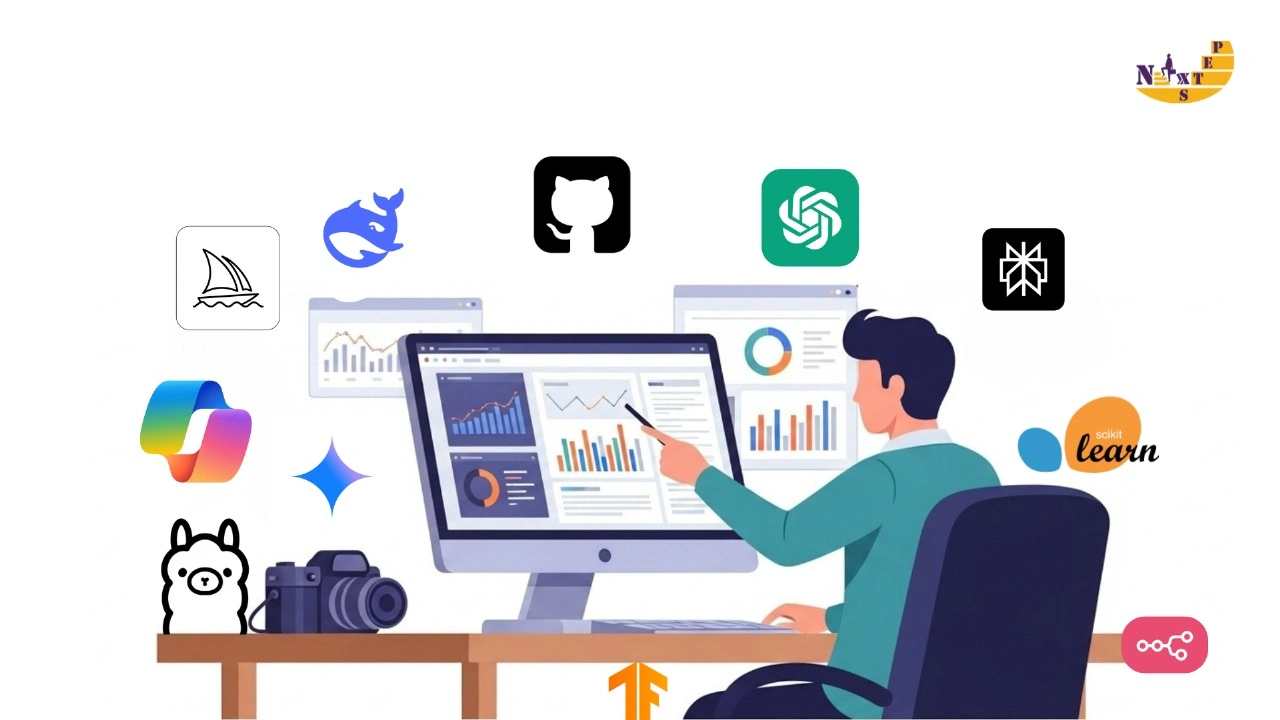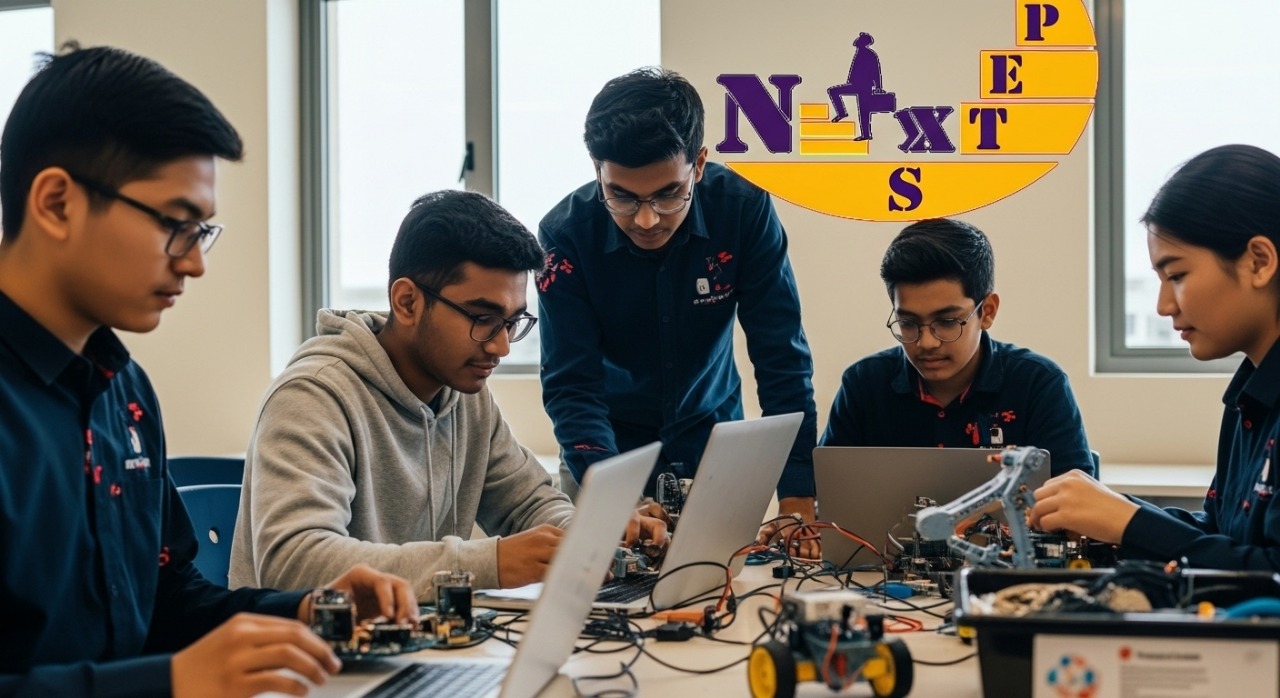Essential AI Tools to Start Your Tech Career

Your Guide to AI Tools: How to Build a Tech Career in Nepal
It seems like you can’t go a day without hearing about Artificial Intelligence. It’s writing articles, creating incredible art, and even helping programmers write code. AI isn’t some far-off sci-fi idea anymore—it’s here, and it’s changing how we work. Global studies like McKinsey’s State of AI in 2025 and the World Economic Forum’s AI and the Future of Work highlight how artificial intelligence is reshaping industries worldwide.
For anyone in Nepal looking to build a career in tech, this is fantastic news. This isn’t just another trend; it’s a huge opportunity. Reports from TechLekh and ICT Frame highlight Nepal’s rapidly expanding AI and IT industry. Learning how to use AI tools is the single best way to get ahead, and this guide is here to show you exactly how to get started.
At NextStep InfoTech, we love helping our students find their place in the tech world. So let’s break down what these tools are, which ones you should know, and how you can go from being curious about AI to building a real career with it.
So, What Exactly Are AI Tools and Why Bother Learning Them?
Let’s keep it simple. AI tools are just apps or software that use artificial intelligence to do things that normally require a human brain. Think about tasks like writing an email, designing a logo, finding patterns in a giant spreadsheet, or even having a conversation.
But what does this actually mean for your career?
- They Make You Way More Productive: An AI tool is like having a super-smart assistant. A developer using GitHub Copilot can write code twice as fast. A marketing student can come up with 20 different ad slogans in seconds using ChatGPT. Employers love this kind of efficiency.
- These Are the Skills Companies Are Hiring For: Right now, companies in Nepal and all over the world are looking for people who know how to use AI. Putting “Proficient with AI tools” on your resume is quickly becoming a must-have, not just a nice bonus.
- They Free You Up to Be More Creative: Don’t worry, these tools aren’t here to replace your brain. They’re here to handle the boring, repetitive stuff. The AI can sort through the data, which lets you focus on the bigger picture—strategy, creativity, and solving interesting problems.
- They’re Creating Brand-New Jobs: Roles like “Prompt Engineer” or “AI Specialist” didn’t even exist a few years ago. By learning these tools now, you’re opening the door to exciting new career paths that are only going to grow.
Let’s Break Down the Most Important AI Tools
The world of AI is massive, but most tools fall into a few key groups. Here are the categories that matter most, with some great examples you can try out today.
1. Generative AI: The Idea and Content Machines
This is the category everyone’s talking about—AI that can create brand new things from scratch.
- ChatGPT & Google Gemini (for Text): Think of these as your brainstorming partner. You can ask them to draft an email, help you debug a piece of code, explain a difficult topic, or even write a poem. They understand what you’re asking and can give you surprisingly good answers.
- Midjourney & DALL-E (for Images): These are incredible. You just type a sentence describing an image you want—like “a photorealistic astronaut riding a horse on Mars”—and the AI creates it for you. It’s a game-changer for anyone who needs visuals for projects or marketing.
- GitHub Copilot (for Code): This is an absolute must-have for our MERN Stack and Python students. It works inside your code editor and suggests entire lines of code as you type. It’s like having a senior developer sitting next to you, helping you write better code, faster.
- DeepSeek: A prominent Chinese artificial intelligence (AI) company that develops and releases large language models (LLMs), competing directly with major global AI labs like OpenAI and Meta.
- Perplexity: A search/answer engine that uses large language models (LLMs) + real-time web search to provide direct answers to user questions, rather than just a list of links. It includes features like source citations, conversational query handling, and the ability to handle research-style tasks.
- Ollama: Ollama is an open-source platform that lets you run and manage large language models (LLMs) locally on your computer or server—without relying on cloud APIs. It supports Windows, macOS, and Linux, and allows interaction through the command line, REST APIs, or graphical interfaces.
2. Data Analysis & Machine Learning: The Real Brains
These are the tools that find hidden patterns and make predictions, powering the “smart” features in the apps you use every day.
- TensorFlow & PyTorch: These are the big ones—the industry standards for building professional AI models. They’re the engines behind things like facial recognition and language translation. To use them well, you’ll need a solid understanding of Python.
- Scikit-learn: If you’re just starting your journey into data science, Scikit-learn is your best friend. It’s a Python library that makes it much easier to experiment with machine learning for tasks like sorting data or predicting future trends.
3. Automation Tools: Your Personal Efficiency Army
These tools are all about getting rid of boring, manual work so you can focus on what’s important.
- n8n: n8n is a low-code/no-code workflow automation platform that lets users visually build and customize workflows using drag-and-drop tools or code. It can be self-hosted or used via a managed cloud version.
- Zapier: Think of Zapier as a matchmaker for your favorite apps. Without writing any code, you can set up rules like, “When I get a new email with an invoice, automatically save the attachment to my Google Drive and add a task in my to-do list.” It saves a ton of time.
- UiPath: This is a tool for what’s called Robotic Process Automation (RPA). You can build little software “bots” that copy human actions, like logging into a website, copying data from a spreadsheet, and pasting it into another system. It’s perfect for automating office tasks.
Going from a Casual User to a Pro
It’s fun to ask ChatGPT for a joke, but that’s not going to land you a job. To build a career, you need to understand how these tools work and how you can use them to solve real business problems.
This is where good training makes all the difference. Our goal at NextStep InfoTech isn’t just to show you a list of tools. It’s to give you the foundational skills so you can adapt and succeed no matter how quickly AI changes.
Our AI & AI Tools course is built to take you from beginner to a confident professional. You’ll get your hands dirty with the most important tools while learning the core ideas behind them.
And since AI doesn’t exist in a bubble, our other courses are designed to give you the perfect foundation:
- Python Programming: Python is the language of AI. Period. Our course gives you the strong programming base you need to build and customize AI solutions.
- Data Science Training: This is where you learn to think like a data expert. You’ll go deep into analyzing data and understanding the principles behind the AI models you build.
- MERN Stack Development: Want to build an app with smart, AI-powered features? This course teaches you how to create the full-stack web applications that bring your AI ideas to life.
Your Action Plan for Getting Started with AI
Feeling excited? Good. Here’s a simple, four-step plan to start your journey.
- Just Play: Don’t be intimidated. Sign up for the free versions of ChatGPT or Bard today. Ask them questions. Use them to help with your homework or plan your weekend. Get a feel for what they can and can’t do.
- Pick a Direction: What career are you interested in? If you’re a developer, spend time with GitHub Copilot. If you’re more into business or marketing, see how generative AI can help you write better. If you love numbers, start exploring data tools.
- Build Your Foundation: The real power comes from understanding why things work. The best first step is learning a language like Python. It’s the key that unlocks almost everything else in the world of AI.
- Find a Guide: You can learn a lot on your own, but a structured course with an expert instructor will get you there so much faster. A program like ours at NextStep InfoTech gives you a clear roadmap, hands-on projects, and the mentorship you need to stay on track.
The Future is Here, and You Can Be a Part of It
The rise of AI is creating incredible opportunities, especially for those ready to learn. Knowing how to use these tools is becoming as important as knowing how to use a computer. It’s the skill that will define the next generation of tech careers.
Don’t just sit back and watch it happen. Be a part of it.
At NextStep InfoTech, we’re here to give you the practical, hands-on training you need to become a leader in Nepal’s tech scene. We’re not just teaching a subject; we’re helping you build a career.
Ready to see what you can do with the power of AI?
Take a look at our comprehensive AI & AI Tools course. Give our team a call. We’d love to help you plan your next step.



